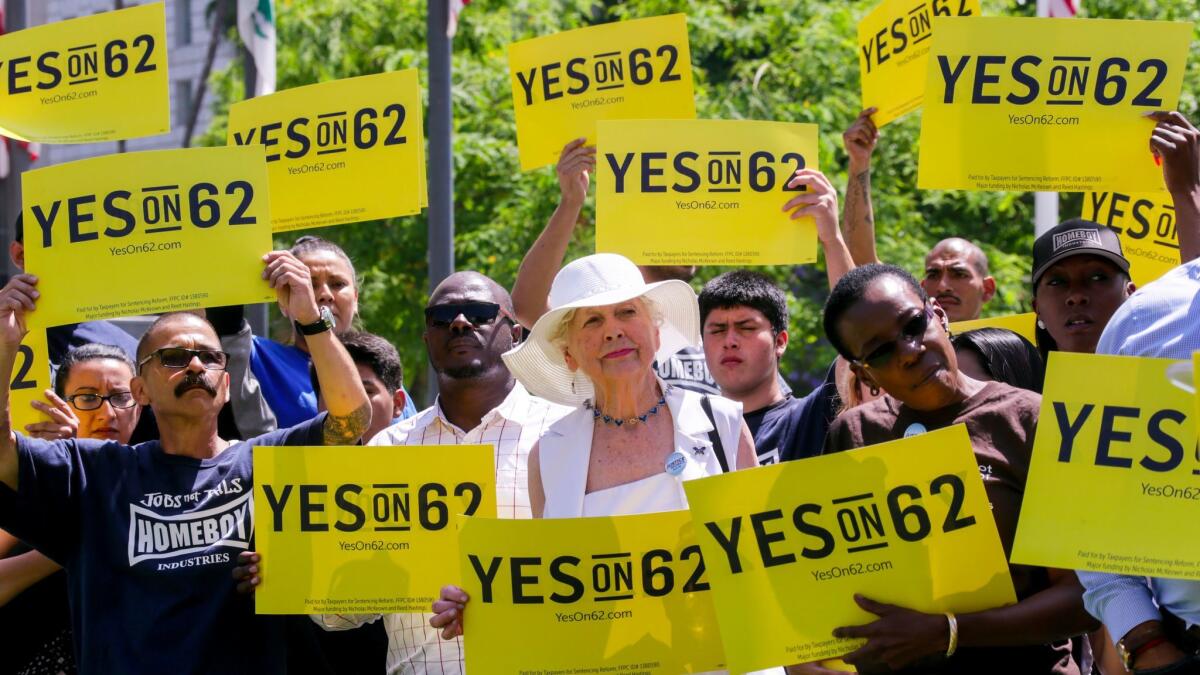Column: Political Road Map: There’s something missing so far from California’s statewide ballot for 2018

Reporting from Sacramento — In the wake of last November’s supersized ballot, which sparked the most expensive ballot measure election in California history, the political arena where initiatives are crafted has been in the midst of a summer of stagnation.
That’s surprising, given the very short time frame left for organizing an effort to get on the ballot in 2018.
Consider where things stood at the same point in 2015. Then, there were 31 initiatives gathering signatures in hopes of landing on the November 2016 ballot. By late summer, another 24 proposals were being reviewed by the attorney general. Out of all of that came 17 propositions that ultimately made it to voters.
By contrast, there are only five initiatives now in the signature-gathering phase. Nine others are awaiting a formal vetting.
“It’s definitely been quiet,” said Gale Kaufman, a Democratic campaign consultant who’s one of the state’s most successful ballot measure strategists. “I think people are taking their time.”
Time, though, is starting to run short. The secretary of state’s office has advised political groups to file proposed initiatives by Aug. 22 to ensure they have the maximum time for making next fall’s ballot.
And that’s important when it comes to the task of collecting voter signatures — 365,880 signatures for new statutes such as last fall’s initiative legalizing recreational marijuana, even more to amend the state Constitution. Election law allows 180 days to complete the process. The more money that an interest group has, the faster it can gather signatures.
Early efforts are cheaper, requiring perhaps less than $2 million for the cost of paying contractors to gather signatures at farmers markets or grocery store parking lots during the lean months when they’re looking for work. Wait until there are a glut of measures, though, and signature drives can cost triple that amount.
Late campaigns also can collapse through mistakes in the petition process. Citizens who sign an initiative outside a supermarket might not be registered to vote. They may have signed it in a county other than where they live. They may have forgotten to list their mailing address.
All of those signatures would be declared invalid. And a high rate of errors can trigger a mandatory review of each signature, which can tack on an additional month. Those who begin late won’t have time to spare, as the list of ballot initiatives will be certified at the end of June 2018.
Might some groups simply stay on the sidelines? In the new era of President Trump, political professionals simply don’t know who will show up to vote.
“Does it mean, as some would like to suggest, that Democrats are highly energized and will vote in record numbers?” Kaufman said. “Or does it mean that people are so turned off that they won’t vote?”
The question looms large. Interest groups don’t spend tens of millions of dollars without a good read on the electorate, and Trump has jumbled the political landscape. Some groups may not spend money on propositions but, instead, on efforts to shift the balance of power in Washington.
Political Road Map: No California congressional district has Republicans in the majority »
“I think a lot of people now have other priorities,” Kaufman said.
Procedural changes, too, may be at play. This is the first full two-year election cycle after a 2015 law that raised the initiative filing fee from $200 to $2,000. Lawmakers believed it would discourage frivolous proposals, but it may also have dampened the interest from smaller activist groups whose ideas would otherwise have had more time to catch fire.
Political professionals may not like to admit it, but they’re stumped about what comes next. Groups on opposite sides of the political spectrum are eyeing each other carefully. It may be a while longer before we know whether they’re really thinking about taking a pass on 2018, or if this is just the calm before the storm.
Follow @johnmyers on Twitter, sign up for our daily Essential Politics newsletter and listen to the weekly California Politics Podcast
ALSO:
For young homeowners, a proposed 2018 initiative could make buying a new house less expensive
Updates on California politics and government











